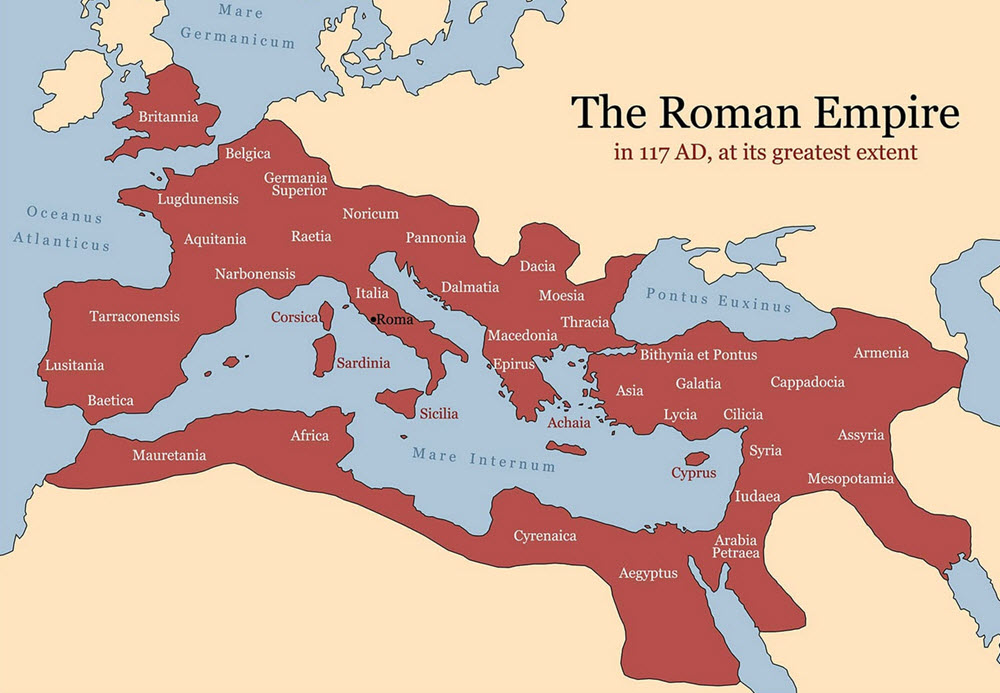From being just one of Italy’s many city-states, Rome became an empire that went all the way up to Scotland, down to Syria and North Africa. The secret behind the success of the Romans was a mixture of military strength, developed architecture and a great respect for other cultures.

The Roman Empire, the ancient empire, was centred around the city of Rome. It was founded in 27 BC, after the fall of the Roman Republic. It continued to grow until 500 AD.
The tactics and discipline of the Roman army made it possible for the Roman Empire to expand and survive.
Fall of the republic
Civil war and disturbances in the first century BC. made Rome go from being a republic to becoming an empire. It was during this period that Julius Caesar eventually took full power over Rome as its dictator. He was murdered in 44 BC, and after him reigned Marc Antony, Lepidus and Octavian, Caesar’s nephew. It did not take long before Octavian declared war against Antony and won.
Emperor Augustus
He was crowned the first emperor of Rome, Augustus. He reigned during the years 27 BC. to 14 AD. Those were stable years without war.
Augustus established a principality that was a combination of a republic and a monarchy. There was still a senate as before, but it was Emperor Augustus who ruled over it.
Expansion
Rome defeated other small Italian states and thus succeeded in taking over all of Italy. After the three long wars, the s.k. Punic wars against the North African city Carthage, Rome became a great power. The Punic wars took place between 262 BC and 146 BC and ended with the Romans conquering Carthage and burning the city to the ground.
The Phoenicians living in Carthage dominated almost the entire western Mediterranean before that. This victory meant that Rome’s borders had moved outside Italy. In the same year, the Greek Empire and parts of the Asian coast were conquered.
In 121 BC, most countries around the Mediterranean belonged to the Romans.
Problems in the empire
The Romans collected a lot of gold and slaves through their conquests but problems started. The farmers who returned could not produce anything on their land and were forced to sell the farms. When they had no property left they were called proletarians. To survive, they sold their voting rights to the patricians in exchange for a meal.
Another problem was that the military consisted of several smaller armies that were led by individual generals. If there was a conflict between generals, a civil war started immediately. So it was both outraged farmers and soldiers who could start a rebellion against the state at any time. The senate did not know what to do with the new development of the empire. Something big needed to happen to prevent the empire from collapsing from within.
Pompey, Crassus and Caesar
In 60 BC, three powerful warlords decided to take over the kingdom together. It was Pompey, Crassus and Caesar. They began their conquests on the outskirts of the kingdom and worked their way inward. Caesar conquered northern Gaul after nine years of the campaign. Pompey marched east with his troops and conquered Syria and Palestine. Caesar, however, felt that he wanted to rule Rome by himself. He crossed the Rubicon River in northern Italy, broke the pact with Pompey, and went straight after Rome. There was a long-running civil war between the two, but Caesar ended up as the winner. Pompey was assassinated, and Caesar appointed dictator for life in 45 BC.
When Caesar began to rule, the problems in Rome and the conquered provinces ended.
He founded certain reforms for the benefit of the poor and distributed plots of land to them. The Senate began to fear that their power would diminish and had Julius Caesar assassinated in 44 BC. His heir Octavian took over and became Rome’s first emperor under the name Augustus, in 31 BC.
